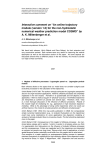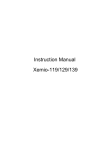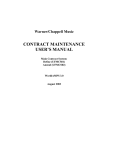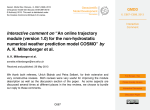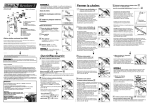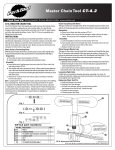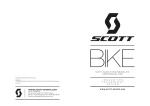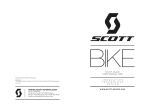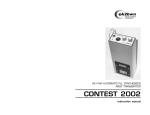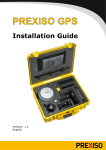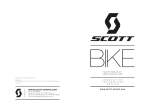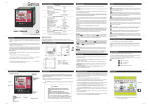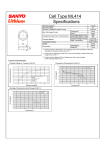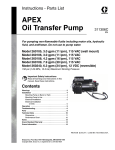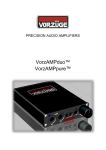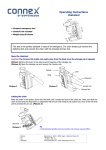Download Service manual
Transcript
USER MANUAL INTENDED USE This bike has been designed for dirt/street riding. These disciplines concentrate on performing tricks after jumping from a previously prepared jump. Landing takes place on an inclined surface. In case of dirt jumping the obstacles are either artificially created or as the name suggests - dirt. Street riding uses urban infrastructure of similar shape. Both disciplines can be categorized as freestyle sports where style is more important than time, speed or distance. A bike designed for that type of riding has many unique features like single speed drivetrain or low frame standover. Hardtail bike geometry makes the rider position straightened out and it’s optimized for jumps and tricks. Take into consideration that a strong, purpose built frame and proper components have limits to the security and durability they provide. Rider skill and picking the right obstacles are as important. When the jumps are big and the biker inexperienced, even the best bike can’t always save him from harm. Before every ride check your components: stem bolts connecting it to the steerer tube as well as the bars, tire pressure, as well as the condition of your seat, steerer tube, brakes, hubs, cranks and pedals. Always use a helmet, gloves and special guards that minimize chances of injury. In case of bike malfunction or when not sure about your service skills contact the nearest dealer or service. Any signs of corrosion as well as loud and atypical performance of components are a sign that it’s necessary to do a maintenance, service or cleaning and conservation. Use only proven components. All mechanical devices (ie. bikes) are subject to wear and exceeding its limit may cause in unexpected damage. Different parts are made from different materials as well have different share of use and stress therefore some will wear faster. When inspecting the bike look for cracks, scratches or changes of color on parts subject to stresses. If you find any of them it may indicate that the part is damaged and needs replacement. 1 PROPER BIKE USE To keep the bike in good technical condition keep it clean and service it regularly. Maintenance frequency depends on the amount and intensity of riding. Before starting to use the bike it is important to check whether: drivetrain, gears and cockpit components function properly pedals, bars, stem, headset, seat and seatpost are properly set-up and tightened hubs, bottom bracket and pedals as well as other screws are properly tightened and have no play (proper torque of important components on the right) wheels are true tires have proper pressure and tread pattern is still present brakes and brake components work and are not worn down there are no leaks from the brakes or fork ATTENTION: Aforementioned checks should be done by the seller during purchase. It’s buyers responsibility to control it. For security measures it is very important to properly select the terrain and riding conditions so that they comply with the bikes construction, designed use and components. PROPER TORQUE FOR IMPORTANT BIKE COMPONENTS*: Rear wheel bolts: 27Nm Front wheel bolts: 17Nm Bar clamp bolts:17Nm Stem bolts on the steerer: 10Nm Seatclamp: 7Nm Seatpost: 18Nm *Unless stated different by the producer HUBS Wheel Hubs need to be properly set up. Improper alignment may increase wear. Permissible play is around 0.3mm. Remember about proper tightening of hub bolts, depending on the hub axle and screws. In case of a 20mm axle you need to tighten both the axle and the counter screw with a 8mm hex key*. Rear hub should be tightened with a flat wrench. CHAIN Chain condition influences the condition of all drivetrain parts so chainrings, cassette, drivers and derailleur. Keep the chain clean and lubed. You can easily check the chain wear/stretch using a simple chain tool available at most bike shops. We suggest using Park Tool or Wippermann tools. While using single speed bikes ensure the chain is tensioned properly. Adjust it by moving the hub in the horizontal frame dropouts. Remember that a too tight chain will wear faster while a loose one will fall off. *applicable to RST forks RIMS It’s very important to check if the rims are centered properly and have no cracks. Take special notice of the area around the spoke nipples. Upon noticing a fracture replace the rim immediately. Using an over abused rim may result in catastrophic failure and crashes. 2 SPOKES Regularly check spoke tension as it directly influences wheel stiffness, centering and with them bike stability. First check should be done directly after purchase. Wheel truing requires skill and precision, that is why we suggest leaving it to qualified bike mechanics. Contrary to popular belief it’s not easy to true a wheel and it is one of the most difficult maintenance activities. That’s why it’s better to leave that in the hands of skilled wheel builders that use spoke tension tools like Park Tool TM-1. It allows for a manual hand check of spoke tension and whether it complies with the value suggested by the manufacturer what in turn allows for perfect wheel triunes. TIRE PRESSURE Proper tire pressure allows for a good balance between traction and rolling resistance. In case of a worn thread pattern immediately change the tire. It’s very important to remember that proper condition and pressure have a large influence on ride safety. Depending on the terrain the pressure should be between 2.5-4.0 Bar. Take into consideration the pressure constraints given by the tire manufacturer that can be found on the side of the tire. BEFORE EVERY RIDE MAKE SURE THAT: 1. The wheel bolts are properly tightened. 2. Fork stanchions are clean and undamaged 3. The headset works smoothly 4. Brake cables are not tangled or damaged SUSPENSION FORK Every week, after every 8-10 hours of riding or in case of noticeably worse performance: 1. Check if all the bolts used in the fork are properly tightened. 2. Lube the stanchions with a bit of fork lube (i.e. Stanchion Lube by Finish Line) After every 25-30hours or after the time specified by the manufacturer or in case of noticeably worse performance: 1. Disassemble the fork and carefully clean it from dust, dirt and old grease. 2. Check the fork for signs of cracks, tears or wear. Upon noticing damage or excessive wear exchange the part. Do not use the fork until you install the new part. 3. If all the controlled parts are in good condition (or after replacing the damaged parts), lube all the seals thickly as well as lube-seals, stanchions and valve sets. Put the biggest amount on the lube seal rings. Do not use lubes that contain lithium because they may cause damage to the seals used in the fork. Remember: aforementioned activities should only be done by professional bike mechanics. Improper service may result in fork damage. HEADSET - BEARINGS It’s a bike part that needs special attention. They often face large stresses. There should never be any play in the headset. In such case it not only damages the part but may also result in a dangerous crash. BARS AND STEM Regularly check bar clamp bolt tension. This bike uses an ahead type stem, which means that you can only rise/lower the bars using spacers put between the headset and stem and between the stem and steerer tube cap. Proper bolt tightening is important for all bike parts but in the cockpit area a broken or loose bolt may result in a very dangerous crash. 3 Always use a torque wrench - Park Tool PW-5 (3-15 Nm Torque) or Park Tool PW-6 (10-60 Nm). Comply with the torque suggested by the manufacturer. CRANKSET Check the crankset often for play. It’s also important to check crank and chainring bolts. It’s preferable to do all maintenance in a bike service. PEDALS Often check whether pedals are securely tightened in the crank and that there is no excessive play on the bearings. SEAT AND SEATPOST Ride comfort greatly relies on saddle height and angle. Adjust it to your individual needs. Attention: Maximum seat height has been marked on the seatpost. Never exceed it. Do not over tighten the seatclamp bolt. BRAKES Left brake lever is connected to the front brake and the right one to the rear. Properly setup brake pads should not contact with the disc unless you pull the lever. Never only use the front brake, always both. In case of sudden braking to minimize the chances of sliding first apply the rear brake and after a while the front one. Attention: This bike uses disc brakes. Ask your dealer or service about maintenance and setup. Remember: The wet stopping distance is longer by around 60%. BIKE CONSERVATION Bike conservation is a very important yet often omitted element of its use. Whenever you buy a bike you should also make sure that you own the necessary maintenance products. Basic activities (bike cleaning, chain and derailleur lubing) do not require much work while they significantly increase moving components lifespan. Regular maintenance with proper products will save you future expenses on prematurely worn down components. We recommend Finish Line products - known for being the best products for bike maintenance. Regular use of Finish Line products will allow you to enjoy your bike working flawlessly silent for much longer. FRAME CLEANING AND MAINTENANCE The best and most effective way to clean your frame is to cover your frame in special cleaning fluid, after a few minutes rinsing it with water and finally wiping it off with a dry, soft piece of cloth. Clean your frame after every ride, especially if it happened in hard atmospheric conditions. For frame cleaning we recommend Finish Line Bike Wash. To keep the frame looking new and fresh conserve it using special product after you clean it. Finish Line Showroom is a good example of such product. Steel frames should be conserved with a special anti-corrosion fluid at least once a year. In case of often use in bad weather apply it more often. CHAIN CLEANING AND MAINTENANCE Keeping chain clean is very important. It directly influences whole drivetrain performance. Dirt, dust and grease are distributed through it all over the drivetrain. After long periods of use in such conditions chain and the connected components will start to wear faster up to a point where the only solution left is exchanging all the mentioned parts. To avoid such costs clean and lube your chain on a regular basis. Clean it after every 4 5-7 rides. We recommend degreasing products like Citrus, Ecotech 2 or Speed Clean by Finish Line or Clean Streak by White Lightning as well as the Finish Line Grunge Brush. Lube all the bolts and plates every 2-3 rides with special fluid to extend the lifespan of your chain. Perform it by rotating the crank backwards while at the same time applying the fluid until you complete a full round. We recommend Finish Line products for it(Teflon Plus for dry conditions, Cross Country for wet weather or paraffin based Kry Tech that will cover the chain with a dry and durable coat) as well as WKS aerosol made by Wipperman and White Lightning Clean Ride or Epic Ride. CABLE BRAKES MAINTENANCE Brake lines have to run smoothly for optimal brake performance. Line lubing frequency depends on conditions and the amount of riding. Check your lines every 4-6 days of riding, in case of noticing any harshness apply the correct fluid. Use a dry condition oil, like Teflon Plus made by Finish Line. Apply a small amount to the open ends of the outer cable. Attention: If the cable condition suggests they need to be taken off, thoroughly cleaned and lubed we suggest you leave it in the hands of a skilled bike mechanic. BRAKE LEVER CLEANING AND MAINTENANCE Basic brake lever cleaning can be done by a simple brush and cloth (EasyPro Brush Set made by Finish Line contains brushes for all bike components) but in case dirt gets inside the lever mechanism it’s necessary to disassemble. We suggest it you take do it in a proper bike service. Lube your brake lever every 6 months. Pull the lever and put the oil on the joint axle while slowly releasing it. Servicing hydraulic brakes can only be done in proper bike workshops. BRAKE DISC CLEANING This bike is equipped with disc brakes. It’s very important to take good care of your disc rotors. Check for cracks, warps as well as clean them often. We recommend Finish Line Speed Clean that evaporates water. In case of a heavily contaminated disc it may be necessary to change your brake pads. FRONT AND REAR HUB MAINTENANCE AND CLEANING Bike hubs use sealed bearings. Clean them on the outside and in case of noticeably worse performance replace bearings with new ones in a bike service. When reinstalling the hubs make sure that bearings run smooth yet without any noticeable lateral or vertical play. Threaded joints should be protected by Finish Line Anti-Seize. BOTTOM BRACKET MAINTENANCE AND CLEANING The bottom bracket uses sealed bearings. Clean them on the outside and in case of noticeably worse performance replace them with new ones in a bike service. Threaded joints should be protected by Finish Line AntiSeize. FORK BEARINGS - HEADSET MAINTENANCE To check whether there is no play in the headset bearings lock the front brake and try to move your bars in the front-back axis. In case of noticing play it should be fixed immediately. Headset should be cleaned and lubed at least once a year. Threaded joints should be protected by Finish Line Anti-Seize. STEM AND SEATPOST MAINTENANCE If the stem creaks it means that some of the bolts are not properly tigh- 5 tened and it is loose or that dirt got between it and the steerer tube. To clean it loosen the bolts, take it of the steerer tube and use a degreasing fluid (i.e. Citrus, EcoTech 2 or Speed Clean made by Finish Line). When mounting the stem on the steerer tube remember to use the proper torque suggested by the manufacturer. To avoid the seatpost seize in the seattube you should cover it with a thin layer of lubricant (ie. Finish Line Teflon Grease) around the point where it touches the seat clamp. Threaded joints should be protected by Finish Line Anti-Seize. PRE-WINTER MAINTANANCE. When the season ends clean your bike with a special soft brush and a special bike shampoo (i.e. Finish Line Bike Wash). Reach all the hidden slots (remove the wheels for better access). Clean any grease with a brush and a special degrease fluid (i.e. Circus, EcoTech2 or Speed Clean made by Finish Line or Clean Streak made by White Lightning) afterwards wipe it off with a soft piece of cloth. It’s best to wax all the polished and painted areas with a proper fluid (i.e. Finish Line Showroom). Re-grease all the bearings. Clean all the remaining components like: brakes, derailleurs, brake levers shifters and other parts. Degrease and clean the chain thoroughly with a brush, than dry and lube it. Same applies for lines and cables - lube them too. Check the condition of rims, tires and spokes. Lower tire pressure by 50 percent. Check all the bolts and threaded connections. Keep your bike in a dry place. It’s good to listen to these advice year round. 6








